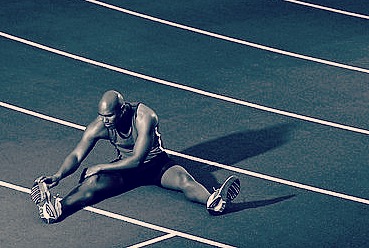Stretching exercises before running was thought to be a major necessity to help loosen-up the body and prevent injury. Although the magic formula for optimal running economy and injury prevention involves forefoot running through barefoot adaptations, it certainly does not include stretching exercises for running.
Stretching Exercises Before Running Spoils a Runners Balance and Performance
According to past reports, stretching exercises for running, usually performed before running, can be hugely debilitating on performance and health.
These finds are a reminder of a more basic truth: our barefoot running ancestors were better endurance runners than the average modern-day jogger and they never stretched.
Inflexibility Is Better
A long line of fascinating and attention-grabbing studies revealed why runners should think twice about stretching before they run.
For instance, Gleim et al. reported that the most economical runners were the least flexible and were most economical between running speeds of 3 kph to 11 kph compared to runners who stretched. Moreover, the less flexible runners appeared to have better pelvis stability at touchdown.
Craib et al. also found that inflexibility of the hip and calves was associated with better running economy in well-trained male distance runners. Why? Again, the runners showed better lower-body stability which reduced muscle activity needed for balance control.
Last but not least, one study found that trunk inflexibility was related to better running economy in international standard male distance runners.
Stretching Makes Your Legs Less “Springy”
The most provocative findings come from studies that show stretching influences the spring-behavior of the leg in a way that impairs running economy.
Spring compression, also referred to as elastic energy storage, is why forefoot runners are more economical than heel strike runners.
The anterior position of the center of mass literally compresses the tendons of the hind-leg during stance in forefoot running (think of hopping up and down on a pogo-stick).
Further, the eccentric phase of forefoot running allows the Achilles to suck up tons of elastic energy. But to maximize elastic energy storage, you need a nice, tightly compressed spring (tendon).
What would happen if you continuously stretched a tightened spring?
The tightness unravels and over time, the spring has a weakened capacity to store elastic energy. The result is a tendon that is less prepared to ‘spring’ or store elastic energy during forefoot running.
Numerous reports suggested that tighter spring compression via a tighter musculo-tendinous system would enhance elastic energy storage during running. Therefore, tendon-tightness is good, loose tendons via stretching are bad.
The Take Home Message
Based on the facts, there is nothing particularly helpful with stretching exercises for running.
For some reason, many runners are unable to abandon their pre-run stretch routine primarily because they associate good flexibility with running efficiency and better joint, muscle health etc. This prevents runners from overcoming the preconceived notion that stretching equals safety. Yet, the findings from follow-up studies expose the underpinnings of reduced running economy which includes stretch-induced flexibility.
Like it or not, inflexibility is one factor that distinguishes more economical runners from the less economical runners; more economical runners being the least flexible. Furthermore, the bulk of the research on the role of stretching exercises for running in preventing injury is murky.
If you are a newly transitioned forefoot runner who struggles with quirks here and there, ditch stretching all together, for a few weeks until your body adjusts, and see what happens. At least doing so will bolster your running economy.
More from Run Forefoot:
- Why Barefoot Running Will Make You Happy
- How Running Can Cause IT Band Syndrome
- Best Barefoot Style Running Shoes for Forefoot Striking
- Achilles Rehab for Runners
- How Forefoot Runners Use Their Hips to Reduce Impact
- Barefoot Running Learning Resources
References:
Craib MW, Mitchell VA, Fields KB, et al. The association between flexibility and running economy in sub-elite male distance runners. Med Sci Sports Exerc 1996; 28 (6): 737-43.
Gleim GW, Stachenfeld NS, Nicholas JA. The influence of flexibility on the economy of walking and jogging. J Orthop Res 1990; 8 (6): 814-23
Jones AM. Running economy is negatively related to sit-and-reach test performance in international-standard distance runners. Int J Sports Med 2002; 23 (1): 40-3
Saunders et al. Factors affecting running economy in well-trained distance runners. Sports Med, 2004; 34(7):465-485
Bretta Riches
BSc Neurobiology; MSc Biomechanics candidate, ultra minimalist runner & founder of RunForefoot. I was a heel striker, always injured. I was inspired by the great Tirunesh Dibaba to try forefoot running. Now, I'm injury free. This is why I launched Run Forefoot, to advocate the health & performance benefits of forefoot running and to raise awareness on the dangers of heel striking, because the world needs to know.
Latest posts by Bretta Riches (see all)
- Can You Run In Barefoot Shoes? Yes, But DON’T Heel Strike! - 21/07/2024
- Why Cushioned Running Shoes Are Really Bad for Your Feet - 19/07/2024
- Do Cushioned Running Shoes Cause Injuries? - 17/07/2024


Leave a Reply